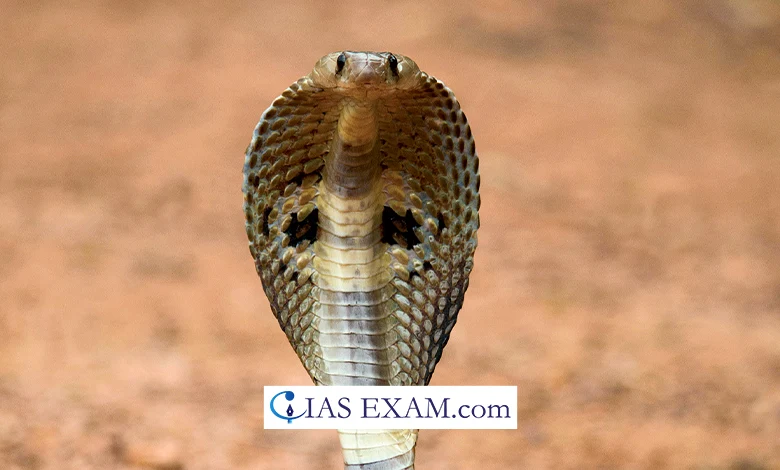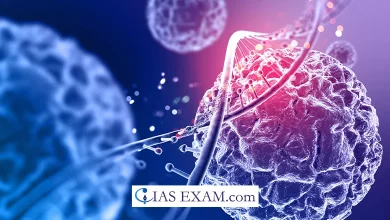Antidote to Cobra and Krait Venom
Syllabus: Science and Technology [GS Paper-3]

Content
A groundbreaking development in the field of toxinology has been achieved with the creation of a powerful antidote to the toxins found in cobra and krait venom.
Details
- Snakebites remain a significant public health concern, particularly in regions where venomous snakes are prevalent.
- Every year, thousands of individuals suffer from the devastating effects of snake envenomation, ranging from tissue damage to paralysis and even death.
- Traditional antivenom therapies have limitations, including limited effectiveness against diverse snake venoms and the risk of adverse reactions.
- However, recent research has brought hope for a more comprehensive solution through the development of novel antibodies targeting specific venom toxins.
Understanding Snake Venom
- Snake venom is a complex cocktail of proteins and peptides designed to immobilise prey and deter predators.
- Different species of snakes possess distinct types of venom, each with its own set of toxic components.
- Three primary types of venom- neurotoxic, hemotoxic, and cytotoxic, target various physiological systems in prey or threats.
- Neurotoxic venom, found in snakes like cobras and kraits, disrupts the nervous system, leading to paralysis and respiratory failure.
- This type of venom poses a significant threat to human health due to its rapid onset and potentially lethal effects.
Challenges in Antivenom Development
- In the past, and in most cases prior to the advent of synthetic antivenoms, serum in the animal after immunisation with snake venoms served as antivenom.
- True, the data classic antivenom therapies have helped many to live but they are yet very limited to snakes.
- A common type of poison will be deficient in tackling a specific one of toxins which are characterised by lack of standardisation of the constituents among species.
- Furthermore, they can be responsible for some undesirable consequences, that begin from the merely common allergic reactions and end up with a hyper-allergic reaction called anaphylaxis.
- For instance, this kind of model is useful because it suggests more specific and must be universally used antivenom therapy.
Breakthrough in Antibody Development
- The ongoing trials, on finding immune training that produces antibodies to counteract the snake venom’s poisoning, have commenced a new series of researches.
- Then, scientists established the identifications of the alpha toxins that occur in elapid venoms. Hence, they concluded that those specific alpha toxins play a role in neurotoxins. They are the epitopes which are recognized by the antibody cells to produce antibodies.
- With scientists discarding billions of antibodies, such drugs will be selected by them that neutralise toxins.
- An antibody named 95Mat5 has proven to be extremely effective in vitro and in vivo experiments, thereby rendering the venom inert and allowing the animals to withstand deadly doses.
Mechanism of Action
- The architecture analysis crystal of the antibody-toxin interaction has led to the revealing of the reasons of the significant effectiveness.
- Following the topology of the toxin-receptor binding, the antibody is capable of jamming the binding of the venom toxin with its receptors on human cells.
- The outcome of such a simulation is that it prevents the binding of toxins to receptor channels, thus, helping interrupt their ability to inflict deadly toxic effects.
- As a result of sequestration of toxins away from target receptors, the antibody becomes an exceedingly strong and harmful-free displacing agent, so it can become a promising research path for antivenom development.
Scope and Limitations
- Although advancements such as am Is of Ant 95 Mat 5 Boost immunity, challenges still hold on the path to a universal antivenom.
- Having shown effectiveness against diverse elapid venoms, such as those from the cobras and kraits, it can now attack different proteins composed of their poison.
- While there are, of course, exceptions such as with an antibody that does not work against a king cobra venom, there are.
- Moreover, the development of immunity against the toxins produced not only from the same snake species but from those in other families, including vipers, is critical to ensure that antivenom is comprehensive.
Conclusion
The development of antibodies targeting specific snake venom toxins represents a promising approach towards the creation of universal antivenom therapies. Recent breakthroughs, such as the discovery of the antibody 95Mat5, highlight the potential of this strategy to mitigate the devastating effects of snake envenomation. While challenges remain, continued research efforts offer hope for a future where individuals at risk of snakebites can receive effective and comprehensive protection against venomous snakes.
Source: The Hindu
UPSC Prelims Practice Question
Q. Which recent advancement holds promise as an antidote against the toxins present in cobra and krait venoms?
a) Development of venom-neutralising antibodies
b) Genetic modification of venomous snakes
c) Traditional herbal remedies
d) Surgical extraction of venom glands
Ans – “a”





.png)



